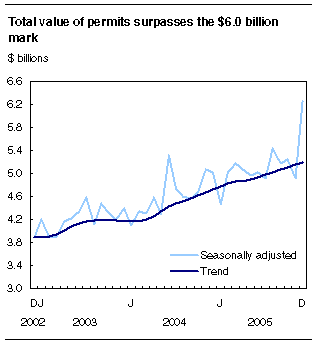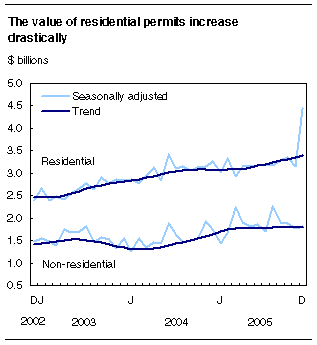
















 |
|
 |                |

|

Monday, February 6, 2006 Building permits
Canada's building boom showed no signs of abating in 2005, as the total value of construction permits roared over the $60-billion mark for the first time following a record month in December. In fact, several monthly and annual records were broken. Contractors took out a record $60.7 billion worth of building permits last year, 9.3% higher than the previous high of $55.6 billion issued in 2004. The level for December alone hit a record $6.3 billion. The annual level of permits has now increased for 10 consecutive years. Construction intentions for the year reached new peaks in every province except Newfoundland and Labrador, Quebec and Manitoba. Last year's surge was due primarily to record investment projects in the non-residential sector, which amounted to $22.0 billion, up 17.6% from the $18.7 billion issued in 2004. Non-residential permits rose in every province, except Quebec and Manitoba, but it was the vigorous economies of Alberta and British Columbia that fuelled most of the gain. If these two provinces were excluded, the annual value of non-residential permits would have risen only 3.3%. In the housing sector, the value of permits rose 5.1% to $38.7 billion in 2005, fuelled by strong demand for new multi-family dwellings. The value of single-family permits remained almost unchanged. Again, Alberta and British Columbia were behind this increase, as the value of residential permits fell 1.5% in all other provinces and territories combined. The demand for new housing clearly remained strong. Municipalities authorized the construction of 238,830 new dwelling units last year, down a slight 1.1% from 2004, but still the second highest number since 1987. Regionally, double-digit growth was recorded in the total value of permits in every metropolitan area in the three westernmost provinces. Annual gains in Calgary, Edmonton and Vancouver greatly surpassed increases in all other metropolitan areas, thanks to strong increases in both residential and non-residential components. In contrast, Toronto and Montréal showed the biggest losses.
Non-residential sector: Strong advances in all three componentsAll three components contributed to the record year for non-residential construction intentions. The value of commercial permits hit a record high $12.0 billion, up 18.5% from 2004 and the second annual record high in a row. A record value for hotel and restaurant buildings and strong construction intentions for office buildings were behind this huge increase. The institutional component rose 17.4% to $6.0 billion, also a record high. This growth was based mainly on strong construction intentions in the education and medical categories. Industrial construction intentions rose 15.1% to $4.0 billion in 2005, the smallest annual gain among the three. The main factor behind this gain was construction projects for manufacturing buildings and in the utility and transportation categories. Provincially, the largest annual increase (in dollars) occurred in Alberta where the value of non-residential permits soared 68.8% to a record $4.2 billion, thanks to gains in all three components. In British Columbia, the value of non-residential permits surged 54.7% to $3.2 billion. Gains were posted in 20 of the 28 census metropolitan areas in the non-residential sector last year. The strongest growth occurred in Calgary, where the value of permits surged 78.1% to $1.6 billion and where all three components increased. This robust growth was based mainly on strong construction intentions in the office building category. Non-residential permits also rose a significant 36.8% to $1.7 billion in Vancouver. Non-residential building construction benefited from low interest rates throughout 2005, even though contractors had to contend with higher construction costs, which added upward pressure on amounts invested. Strong retail sales, high levels of industrial capacity utilization and tighter office vacancy rates in several centres also contributed to the robust gains. Housing: Demand shifts toward multi-family unitsDemand in the residential sector shifted last year toward multi-family dwellings. In 2005, they accounted for 48.9% of all new dwelling units authorized, up from 46.0% the year before. It was the highest proportion since 1982 when they represented 51.2% of all new units. The demand for single-family units declined 6.3% in 2005 as municipalities approved the construction of 122,090 new single units. Despite the decrease in the number of units, the value of permits for single-family dwellings rose 1.0% to $25.2 billion, thanks to higher prices. On the other hand, these high prices led to the shift in demand toward multi-family dwellings. Municipalities authorized 116,740 multi-family units, up 5.1% from 2004 and the highest number since 1977. The value of multi-family permits issued increased 13.5% to $13.5 billion. Among the factors behind last year's strong results in the residential sector were low mortgage rates, growth in full-time employment, the dynamic economy in Western Canada and a high level of immigration. December 2005: Several records tumbleIn December, the value of building permits soared to a record $6.3 billion, up 27.4% from November and 15.3% higher than the previous monthly record of $5.4 billion set in August. December's big gain was the result of a huge jump in the number of approved multi-family projects in Toronto. Several permits related to applications received earlier had to be issued before the end of 2005 in order to avoid higher development charges. Furthermore, building permit fees increased as of January 2006. In December alone, Toronto issued $1.2 billion worth of building permits, more than four times the monthly average of $288 million during the first 11 months of the year. New provincial records for monthly permits were set in Ontario, Alberta and British Columbia. In the housing sector, the value of permits in December hit a record $4.4 billion, up 40.8% from November and 29.7% higher than the previous record set in June 2004. In the non-residential sector, intentions were up a more moderate 3.3% to $1.8 billion, with gains in the commercial and institutional components. The value of multi-family permits more than doubled to a record $2.0 billion, well above the previous high of $1.3 billion in June 2004. Furthermore, the value of single-family permits was up 9.0% to a record $2.44 billion, surpassing the previous peak of $2.41 billion set in December 2004. 
Apart from Ontario's exceptional results in housing, new monthly records were also set in December in residential intentions in Alberta ($659 million) and British Columbia ($796 million). In both provinces, single- and multi-family components contributed to the strong results. The non-residential sector shrugged off three consecutive months of declines in December, increasing 3.3% to $1.8 billion, with seven of the provinces recording gains. The commercial component halted two months of declines, rising 13.2% to $1.1 billion. Alberta showed the strongest growth in this sector, with construction intentions increasing particularly for office buildings. The value of institutional permits increased 3.7% to $454 million. Education and social service buildings were behind this increase. 
The value of industrial permits fell 24.3% to $267 million, the second consecutive monthly decrease and the lowest level in 10 months. All industrial categories showed declines. This was in line with Statistics Canada's latest Business Condition Survey that showed manufacturers were slightly more cautious in their outlook for the first quarter of 2006, compared with the fourth quarter of 2005. Available on CANSIM: tables 026-0001 to 026-0008, 026-0010 and 026-0015. Definitions, data sources and methods: survey number 2802. The December 2005 issue of Building Permits (64-001-XIE, $15/$156) will be available soon. The January 2006 building permit estimate will be released on March 6. To order data, contact Brad Sernoskie (613-951-4646; 1-800-579-8533; bdp_information@statcan.ca). For more information, or to enquire about the concepts, methods or data quality of this release, contact Étienne Saint-Pierre (613-951-2025), Investment and Capital Stock Division.
| ||||||||||||||||||||||||||||||||||||||||||||||||||||||||||||||||||||||||||||||||||||||||||||||||||||||||||||||||||||||||||||||||||||||||||||||||||||||||||||||||||||||||||||||||||||||||||||||||||||||||||||||||||||||||||||||||||||||||||||||||||||||||||||||||||||||||||||||||||||||||||||||||||||||||||||||||||||||||||||||||||||||||||||||||||||||||||||||||||||||||||||||||||||||||||||||||||||||||||||||||||||||||||||||||||||||||||||||||||||||||||||||||||||||||||||||||||||||||||||||||||||||||||||||||||||||||||||||||||||||||||||||||||||||||||||||||||||||||||||||||||||||||||||||||||||||||||
|
|
|